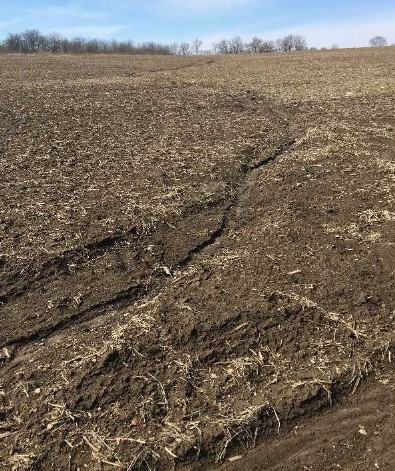By Greg LaBarge
Research measuring nutrient losses from surface and subsurface drainage in Ohio indicates that not all fields contribute equally to various water quality issues. Fields with higher than average potential losses have some characteristics observed during everyday field activities or when working with agronomic records. For example, a stream bank collapsing and sloughing off is adding to downstream sedimentation issues, or a field with a soil test report showing phosphorus levels above agronomic need can result in higher soluble phosphorous losses. Having landowners and operators recognize these higher risk scenarios and react to them by contacting conservation professionals can help speed water quality improvements.
Developing private-public partnerships in which the landowner and farmer are active participants in identifying critical concerns and bringing them to the attention of conservation professionals is a key recommendation in a new Bulletin 969- A Field Guide to Identifying Critical Resource Concerns and Best Management Practices for Implementation and accompanying website
https://agbmps.osu.edu/. The guide was prepared with cooperating agencies and organization through a grant from the Ohio Soybean Council.

The bulletin focuses on erosion, phosphorus and nitrogen. It describes scenarios and provides pictures in which losses of soil, nitrogen and phosphorus resulted in higher quantities or concentrations in studies measuring water leaving at the field edge conducted in Ohio. The bulletin then provides a list of common Best Management Practices (BMP’s) for the different critical concerns. Along with listing best management practices, the bulletin provides the cost, advantages and precautions to consider helping narrow down the best practice to use.
The guide includes practices used on a field, at the edge of a field and within a stream. In-field practices occur in the boundaries of the field such as tillage, cover crops and nutrient applications. Edge of field practices modify water leaving the field with practices such as drainage water management, or filters. In-stream practices modify the stream or filter water moving down the ditch or stream. Practices addressed include erosion control, water control, filters and 4-R nutrient stewardship – proper place, time, rate and source.
The upcoming spring season provides a new opportunity to inventory potential high-risk concerns.
For soil erosion, look for both stream/ditch bank and gullies in the field. Unstable stream banks can continually collapse moving large amounts of soil downstream. Where gullies form annually in a field, use best management practices, such as changing tillage, use cover crops or permanent grassed waterways to slow water movement to reduce soil loss. Studies measure greater nutrient concentrations in water that leaves the field after moving across the soil surface. Rather than direct surface water to a pipe located in the field and out through the tile system as surface water install a blind inlet? A blind inlet is a BMP where water leaving the site infiltrates the soil before leaving via a subsurface perforated pipe system.
Nitrogen losses tend to be higher when using manure and fertilizer in combination for corn or wheat production. Using tests to estimate nitrogen available from manure before applying additional commercial nitrogen can be positive from an economic and environmental standpoint. Changing manure application timing from a fall application to a spring application when the crop is growing will better utilize manure N, replacing purchased nitrogen. Nitrogen losses to waterways occur through field tile during the non-growing season are reduced by using cover crops or water management.
A soil test can indicate the potential for losses in phosphorous. The type of soil, as well as the timing and fertilizer application method, affect the extent of phosphorous losses. A phosphorous index tool can be used to estimate losses and identify the cost and effectiveness of water management BMP’s. Subsurface placement of fertilizer or manure is a good option to reduce risk of loss at nutrient application.
Bulletin 969 is available to people operating in the Western Lake Erie Basin at Soil and Water Conservation Offices serving that region through a grant from the Ohio Soybean Council. Ohio State University Extension Offices in that region have limited copies. Statewide, the printed guide can be purchased for $10 or as a downloadable pdf file $8.50 from
https://extensionpubs.osu.edu/. Content is also available at the website
https://agbmps.osu.edu/.
Source : osu.edu